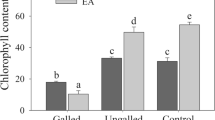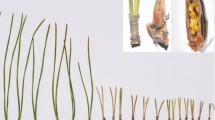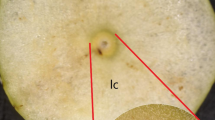Summary
We measured the effects ofEriophyes laevis mite galls on the relative growth of short shoot leaf area ofAlnus glutinosa. A portion of leaves was artificially removed from a set of short shoots with both high and low gall density to cause local stress conditions. Nontreated high and low gall density short shoots were used as controls. The results show that the relative growth of leaf area measured for short shoots is negatively affected by high gall density. Artificial leaf removal, on the other hand, had positive effects on leaf area growth. Interestingly, the growth of leaf area did not differ for high gall density short shoots with leaf removal and noninfested short shoots with no leaf removal. This result may be caused by the combined, opposite effects of leaf removal and gall infestation.
Similar content being viewed by others
References
Abrahamson WG, McCrea KD (1986) Nutrient and biomass allocation inSolidago altissima: effects of two stem gallmakers, fertilization, and ramet isolation. Oecologia 68:174–180
Brown BJ, Allen TFH (1989) The importance of scale in evaluating herbivory impacts. Oikos 54:189–194
Hartnett DC, Abrahamson WG (1979) The effects of stem gall insects on the life history patterns inSolidago canadensis. Ecology 60:910–917
Keifer HH, Baker EW, Kono T, Delfinado M, Styer WE (1982) An illustrated guide to plant abnormalities caused by eriophyid mites in North America. Agriculture handbook number 573, United States Dept of Agriculture
Kikuzawa K (1980) Why do alder leaves fall in summer? Jap J Ecol 30:359–368
Leather SR (1988) Consumers and plant fitness: coevolution or competition? Oikos 53:285–288
Liro JI, Roivainen H (1951) Äkämäpunkit. Eriophyidae. WSOY, Porvoo and Helsinki (in Finnish)
Mooney HA (1986) Photosynthesis. In: Crawley MJ (ed) Plant ecology. Blackwell, Oxford, pp 345–373
Paige KN, Whitham TG (1987) Overcompensation in response to mammalian herbivory: the advantage of being eaten. Am Nat 129:407–416
Price PW, Fernandes GW, Waring GL (1987) Adaptive nature of insect galls. Environ Entomol 16:15–24
Saalas U (1949) Suomen metsähyōnteiset. WSOY, Helsinki (in Finnish)
Sacchi CF, Price PW, Craig TP, Itami JK (1988) Impact of shoot galler attack on sexual reproduction in the arroyo willow. Ecology 69:2021–2030
Sunose T, Yukawa J (1979) Interrelationship between the leaf longevity of the evergreen spindle tree,Eonymus japonicus Thunb. and the euonymus gall midge,Masakimyia pustulae, Yukawa and Sunose (Diptera: Cecidomyiidae) in different environments. Jap J Ecol 29:29–34
Tuomi J, Niemelä P, Mannila R (1982) Resource allocation on dwarf shoots of birch (Betula pendula): reproduction and leaf growth. New Phytol 91:483–487
Vuorisalo T, Walls M, Niemelä P, Kuitunen H (1989) Factors affecting mosaic distribution of galls of an eriophyid mite,Eriophyes laevis, in alder,Alnus glutinosa. Oikos 55:370–374
Weis AE, Kapelinski A (1984) Manipulation of host plant development by the gall-midgeRhabdophaga strobiloides. Ecol Entomol 9:457–465
Weis AE, Walton R, Crego CL (1988) Reactive plant tissue sites and the population biology of gall makers. Ann Rev Entomol 33:467–486
Whitham TG (1978) Habitat selection byPemphigus aphids in response to resource limitation and competition. Ecology 59:1164–1176
Williams AG, Whitham TG (1986) Premature leaf abscission: an induced plant defense against gall aphids. Ecology 67:1619–1627
Yukawa J, Tsuda K (1986) Leaf longevity ofQuercus glauca Thunb., with reference to the influence of gall formation byContarinia sp. (Diptera: Cecidomyiidae) on the early mortality of fresh leaves. Mem Fac Agr Kagoshima Univ 22:73–77
Zar JH (1984) Biostatistical analysis, second edition. Prentice Hall, New Jersey
Author information
Authors and Affiliations
Rights and permissions
About this article
Cite this article
Vuorisalo, T., Walls, M. & Kuitunen, H. Gall mite (Eriophyes laevis) infestation and leaf removal affect growth of leaf area in black alder (Alnus glutinosa) short shoots. Oecologia 84, 122–125 (1990). https://doi.org/10.1007/BF00665605
Received:
Accepted:
Issue Date:
DOI: https://doi.org/10.1007/BF00665605




